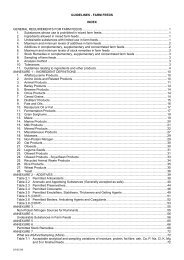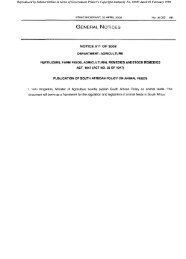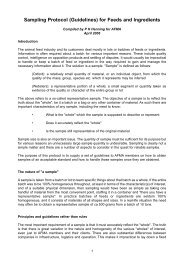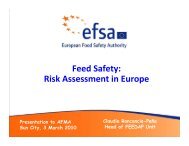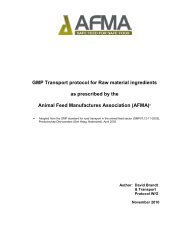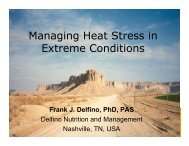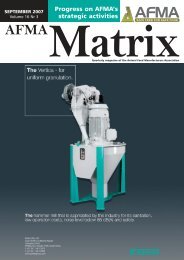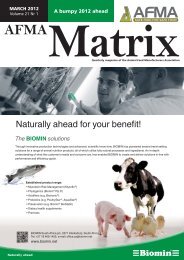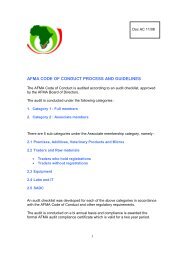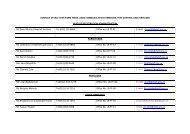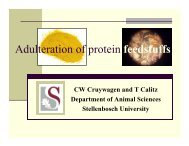You also want an ePaper? Increase the reach of your titles
YUMPU automatically turns print PDFs into web optimized ePapers that Google loves.
The way feed is presented will affect<br />
energy and time required<br />
to consume it. Poultry activity<br />
or behaviour has not received<br />
as much research attention as<br />
other areas when considering performance.<br />
In our modern production environments,<br />
there has traditionally been little<br />
perceived economic value in understanding<br />
or monitoring bird behaviour.<br />
Most of the focus in broiler production<br />
has been on genetic progress, strain selection,<br />
feeding programmes and management<br />
systems rather than on how the bird<br />
responds to such changes. However, bird activity<br />
is responsible for the major energy loss<br />
between consumed dietary metabolisable<br />
energy and the amount of energy retained<br />
as tissue, and so it merits consideration.<br />
Using pellet quality to<br />
improve broiler growth rate<br />
and feed conversion<br />
By Dr Chet Wiernusz, director of world feed milling and nutrition at Cobb-Vantress<br />
Activity and energy consumption<br />
Depending on the management system in<br />
place, 20% of metabolisable energy intake<br />
(MEI) is used for activity. In other words,<br />
assuming that 14,287 Kcal ME must be<br />
consumed to produce a 2,5kg broiler, approximately<br />
2,858 Kcal ME is used for activity.<br />
Therefore, reducing activity energy expenditure<br />
by approximately 6% would save<br />
a considerable amount of energy.<br />
Pelleting poultry feeds has been long<br />
recognised as a method to enhance bird<br />
performance. Pelleting is known to increase<br />
body weight, to reduce feed wastage and to<br />
improve feed conversion.<br />
Its exact mode of action, however, has<br />
been speculative. Work reported by Jensen<br />
et al. (1962) indicated that pelleting did indeed<br />
elevate bird performance through<br />
increased body-weight gain and improved<br />
feed conversion. Additionally, Jensen et al.<br />
(1962) noted that broilers fed pellets spent<br />
less time eating and more time resting than<br />
those fed mash.<br />
Furthermore, the same study reported<br />
that digestibility was not a factor in the improved<br />
broiler performance. Consequently,<br />
bird behaviour may well be a critical factor<br />
for defining the mode of action for pelleting.<br />
If true, then pelleting would also offer an avenue<br />
to manipulate bird energy expenditure<br />
for activity.<br />
Observing behaviour<br />
The importance of bird behaviour and feed<br />
form were examined by Dr Robert Teeter at<br />
Oklahoma State University in the following<br />
two experiments.<br />
Behavioural observations were conducted<br />
by walking past each cage five times<br />
spaced throughout the day and classifying<br />
the broilers into one of nine behaviour categories.<br />
These included eating, drinking,<br />
standing, resting, pecking, preening, walking,<br />
dust bathing and other activity. The five<br />
observations for each bird were then put on<br />
a percent-time basis to create results for data<br />
analysis.<br />
As described by McKinney and Teeter<br />
(2004), bird body weight and feed conversion<br />
values were transformed into effective<br />
caloric value. The effective caloric value represents<br />
the caloric density that would be<br />
needed to achieve the same body weight<br />
and feed conversion result under low stress<br />
conditions. As such, effective caloric value<br />
enables evaluation of calorie savings when<br />
viewed as the difference between values<br />
created by varying nutritional and/or nonnutritional<br />
production scenarios.<br />
In the first study, birds were offered two<br />
feed forms – mash vs. pellets – with treatments<br />
also including birds switched from<br />
one feed form to the other. All birds were<br />
offered the same ration composition, independent<br />
of feed form, and allowed to consume<br />
feed ad libitum.<br />
Despite the fact that all birds were provided<br />
a 3,050 Kcal ME/kg ration, the range<br />
of an effective caloric value for individual<br />
birds was from 2,450 Kcal when a bird spent<br />
20% of its time resting to 3,550 Kcal when<br />
a bird spent 85% of its time resting, creating<br />
a spread of 1,100 Kcal of effective caloric<br />
value/kg ration.<br />
Encouraging quick consumption<br />
The importance of bird activity as a source<br />
of energy wastage is clear. Yet another factor<br />
impacting bird behaviour appears to be<br />
Processing<br />
<strong>AFMA</strong> MATRIX ● APRIL <strong>2013</strong> 35



